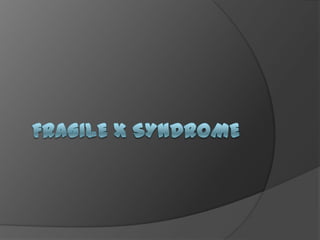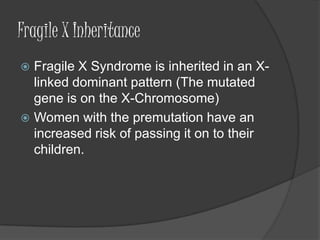Fragile x Syndrome 2.0
- 2. Fragile X SyndromeIs the expansion of a single trinucleotide gene sequence (CGG) on the X chromosome.This expansion results in a failure to express the protein coded by the FMR1 gene.The expression of this protein is required for normal neural development.
- 3. At full mutation, the CGG sequence can be repeated more than 200 times (29-31 is normal)
- 4. Because females have two X-Chromosomes, they are much more likely to develop Fragile X Syndrome than males (1 in 3600 for males, and 1 in 4000-6000 for females).
- 5. Fragile X Physical PhenotypeProminent earsElongated faceHyperextensible finger jointsDouble-Jointed thumbsFlat feetSoft skinLow muscle tone
- 6. Persons with Fragile X Syndrome are likely to produce intellectual disabilities.Children with Fragile X Syndrome have a learning rate with is 2.2 slower than children without the syndrome.
- 7. Fragile X and AutismAlthough Fragile X can cause a child to have Autism, not all children with Fragile X have Autism.Approximately 2%-6% of children diagnosed with Autism were found as having Fragile X as the cause, while approximately one third of children who have Fragile X show signs of autistic behavior.
- 8. Living with Fragile XPersons with Fragile X Syndrome do not have a lower life expectancy than those without.Social Anxiety is often related to Fragile X. Trouble forming relationships, avoiding eye contact, trouble reading facial coding, and hyperactivity are symptoms.
- 9. I cannot begin to imagine what living with Fragile X would be like, but I have lived with someone who had the syndrome. Living with someone who has Fragile X can require a complete change in lifestyle, but not always.
- 10. Fragile X InheritanceFragile X Syndrome is inherited in an X-linked dominant pattern (The mutated gene is on the X-Chromosome)Women with the premutation have an increased risk of passing it on to their children.
- 11. TreatmentsAs of yet, the only treatments that one can have for Fragile X are behavioral therapy and special education. There is no cure for Fragile X, but there is hope that as more is discovered about Fragile X, a cure might become possible.
- 12. Bibliography"Fragile X Syndrome - Genetics Home Reference."Â Genetics Home Reference - Your Guide to Understanding Genetic Conditions. 15 May 2011. Web. 22 May 2011. <http://ghr.nlm.nih.gov/condition/fragile-x-syndrome>."Fragile X Syndrome - PubMed Health." 12 May 2010. Web. 23 May 2011. <http://www.ncbi.nlm.nih.gov/pubmedhealth/PMH0002633/>."The National Fragile X Foundation."Â The National Fragile X Foundation - Fragile X Syndrome. Web. 23 May 2011. <http://www.nfxf.org/html/home.shtml>











